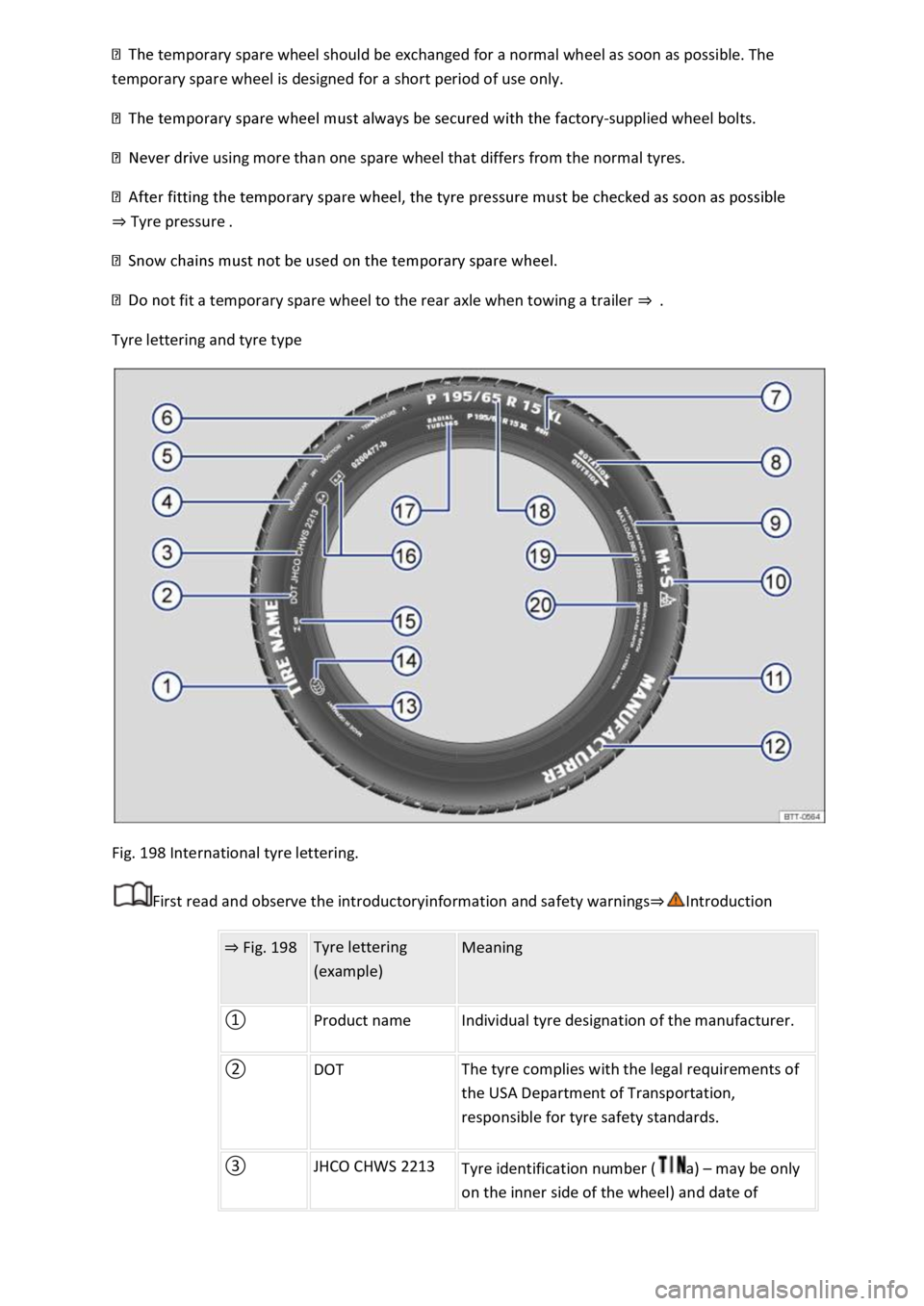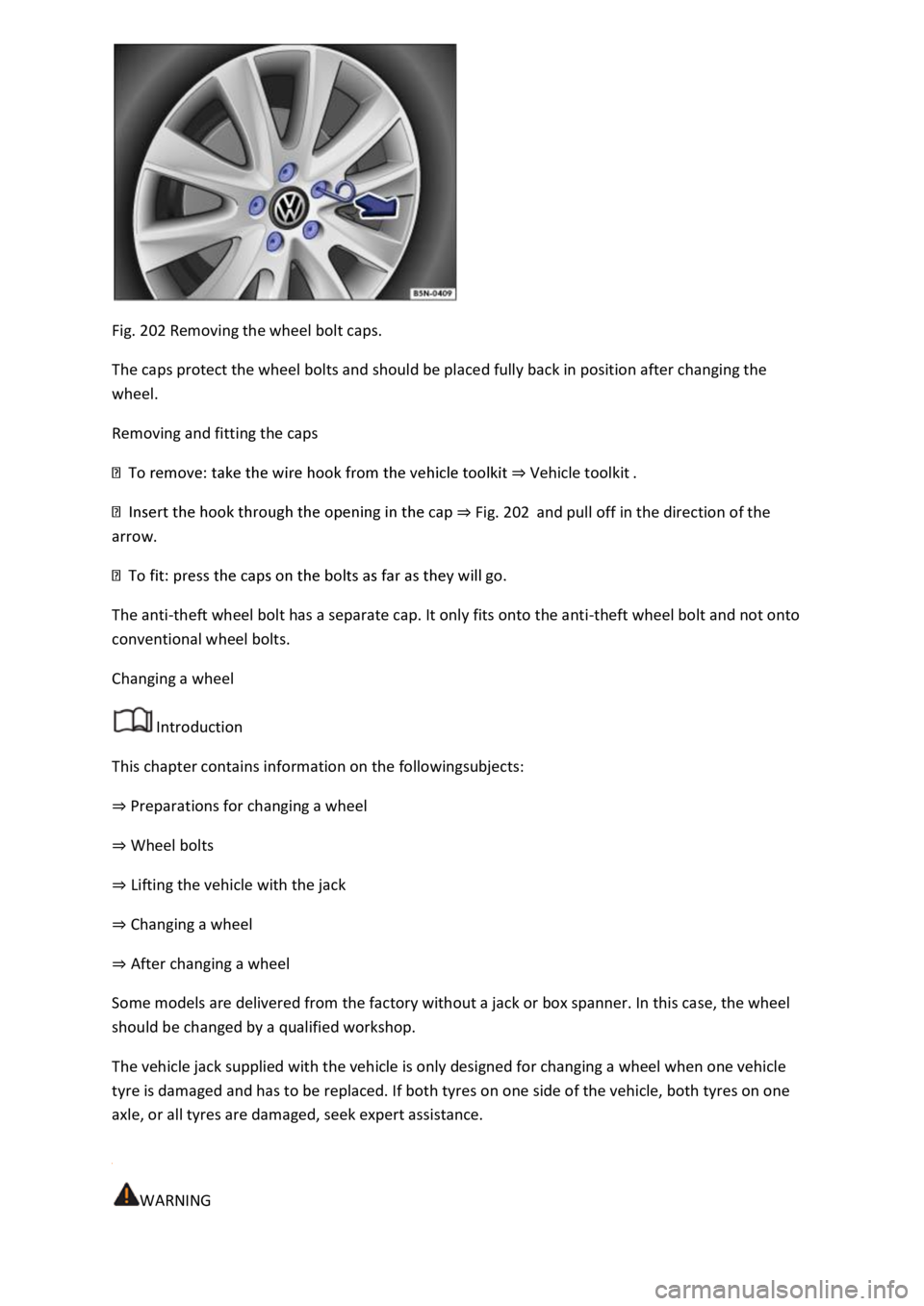2021 VOLKSWAGEN T-ROC change wheel
[x] Cancel search: change wheelPage 398 of 502

Replacing tyres
lace tyres at least on an axle-by-axle basis ⇒ .
type.
-approved tyres.
Re-synchronising the Tyre Pressure Loss Indicator
The Tyre Pressure Loss Indicator must be re-synchronised each time one or more wheels is changed.
This also applies if the wheels have been swapped, e.g. from the front to the rear ⇒ Tyre monitoring
system .
WARNING
Aggressive liquids and other substances can cause visible and invisible damage to the tyres, which
can cause the tyre to burst.
from the tyres.
WARNING
Even if they have not been used, old tyres can suddenly lose pressure or burst, especially at high
speeds, and thus cause accidents and serious injuries.
ith
extra care at all times.
WARNING
New tyres must be run in as they initially have reduced grip and braking efficiency.
km in order to prevent accidents and serious injury.
WARNING
Wheels must have the necessary clearance. If the wheels do not have the necessary clearance, the
tyre could rub on parts of the running gear, vehicle body and the brake lines. This can lead to a fault
in the brake system and to tread separation and thus to a tyre bursting.
and must not rub on any vehicle body parts.
Page 406 of 502

temporary spare wheel should be exchanged for a normal wheel as soon as possible. The
temporary spare wheel is designed for a short period of use only.
-supplied wheel bolts.
ve using more than one spare wheel that differs from the normal tyres.
⇒ Tyre pressure .
ot fit a temporary spare wheel to the rear axle when towing a trailer ⇒ .
Tyre lettering and tyre type
Fig. 198 International tyre lettering.
First read and observe the introductoryinformation and safety warnings⇒Introduction
⇒ Fig. 198 Tyre lettering
(example)
Meaning
① Product name Individual tyre designation of the manufacturer.
② DOT The tyre complies with the legal requirements of
the USA Department of Transportation,
responsible for tyre safety standards.
③ JHCO CHWS 2213 Tyre identification number (a) – may be only
on the inner side of the wheel) and date of
Page 411 of 502

peed index ⇒ .
Speed limitation
Winter tyres have a speed limit depending on the speed index ⇒ Tyre lettering and tyre type .
Speed warning settings can be made and adjusted in the Infotainment system using the
button and the and Tyres function buttons.
If you use V-rated winter tyres, the speed limits and required tyre pressure are determined by the
engine size. In this case, always ask a Volkswagen dealership about the maximum permitted speed
and required tyre pressure.
All-wheel drive (4MOTION)
Thanks to its all-wheel drive, the vehicle has good traction in winter conditions, even with the
standard tyres. Nevertheless, Volkswagen still recommends that winter tyres or all-year tyres should
be fitted on all four wheels in winter, above all because this will give improved braking efficiency.
Observe information on snow chains⇒ Snow chains .
WARNING
The improved driving characteristics afforded by the winter tyres in winter conditions should not
encourage you to take any risks.
driving style to suit visibility, weather, road and traffic conditions.
The vehicle handling is better if summer tyres are fitted at temperatures above +7°C (+45°F). The
rolling noise is quieter, the tyre wear lower and the energy efficiency higher in this case.
In vehicles with a Tyre Pressure Loss Indicator, the system has to re-synchronise after wheels are
changed ⇒ Tyre monitoring system .
Volkswagen dealerships can provide details on permissible winter tyre sizes.
Snow chains
First read and observe the introductoryinformation and safety warnings⇒Introduction
Page 416 of 502

Fig. 202 Removing the wheel bolt caps.
The caps protect the wheel bolts and should be placed fully back in position after changing the
wheel.
Removing and fitting the caps
⇒ Vehicle toolkit .
⇒ Fig. 202 and pull off in the direction of the
arrow.
The anti-theft wheel bolt has a separate cap. It only fits onto the anti-theft wheel bolt and not onto
conventional wheel bolts.
Changing a wheel
Introduction
This chapter contains information on the followingsubjects:
⇒ Preparations for changing a wheel
⇒ Wheel bolts
⇒ Lifting the vehicle with the jack
⇒ Changing a wheel
⇒ After changing a wheel
Some models are delivered from the factory without a jack or box spanner. In this case, the wheel
should be changed by a qualified workshop.
The vehicle jack supplied with the vehicle is only designed for changing a wheel when one vehicle
tyre is damaged and has to be replaced. If both tyres on one side of the vehicle, both tyres on one
axle, or all tyres are damaged, seek expert assistance.
WARNING
Page 417 of 502

Changing a wheel can be dangerous, especially when carried out at the side of a road. Please
observe the following steps in order to reduce the risk of serious injuries:
as soon as possible and when safe to do so. Park the vehicle at a safe distance
from moving traffic in order to carry out the wheel change.
work during the wheel change.
board or similar support for the vehicle jack.
urself when you feel confident with carrying out the procedure. If not,
seek expert assistance.
ver
to the position P or select a gear on a manual gearbox in order to reduce the risk of unintended
vehicle movement.
immediately after changing a wheel.
n the case of vehicles with a Tyre Pressure Loss Indicator, the system must be re-synchronised
immediately after a wheel change⇒ Tyre Pressure Loss Indicator .
Preparations for changing a wheel
First read and observe the introductoryinformation and safety warnings⇒Introduction
Checklist
The following actions must always be carried out in the given order in preparation for changing the
wheel ⇒ :
If your vehicle has a flat tyre, park the vehicle on a firm and level surface at a safe distance from
moving traffic.
Switch on the electronic parking brake Parking and manoeuvring.
DSG® dual clutch gearbox: move the selector lever to position P DSG® dual clutch gearbox.
Switch off the engine and remove the key from the ignition.
Page 422 of 502

When towing a trailer : unhitch the trailer from the vehicle and park it properly.
Loosen the wheel bolts Wheel bolts.
Find the jacking point under the vehicle which is closest to the wheel that is being changed.
Insert the crank into the opening on the jack (depends on the vehicle equipment).
Crank up the jack until it just fits under the jacking point of the vehicle.
Ensure that the entire surface of the foot of the jack is resting securely on the floor, and that the
foot of the jack is positioned fully underneath the point of application and .
Position the jack and simultaneously continue to crank the claw up until it is in position around the
vertical rib underneath the vehicle .
Crank the jack further until the wheel is just clear of the ground.
WARNING
Incorrect use of the vehicle jack could cause the vehicle to slip off the jack. This could lead to severe
injuries. Observe the following points in order to reduce the risk of injuries:
jacks could slip out of position – this includes vehicle jacks supplied with other Volkswagen models.
the vehicle to slip off the jack. If necessary, use a large, sturdy board or similar support for the
vehicle jack.
side member securely ⇒ Fig. 206 .
lace any part of your body (e.g. an arm or leg) underneath the vehicle if the latter is
supported only by the vehicle jack.
Page 437 of 502

Care allergen filter: change.
It is also possible to have servicing work carried out in between the scheduled service events
⇒ Fixed service or flexible service .
The scope of service is subject to change for technical reasons (continuous further development of
components). Your Volkswagen dealership or qualified workshop always has the latest information
about any changes.
Vehicle care
Notes on vehicle care
Regular, expert care helps to maintain your vehicle.
The longer contamination or dirt is left on the surface of vehicle components and upholstery fabrics,
the more difficult it can become to clean and treat them. Extended exposure may mean that it is no
longer possible to remove contamination or dirt.
Volkswagen recommend using Genuine care products that have been matched to your vehicle.1)
Consult a qualified workshop if you have any specific questions or if vehicle parts are not listed.
WARNING
Incorrect care and cleaning of vehicle components can impair the safety features of the vehicle and
cause serious injury.
be cleaned according to the manufacturer's instructions.
airbag modules.
ms against parts with sharp edges, e.g. when cleaning the insides of the
wheel housings.
WARNING
If the windows are covered in dirt, condensation, or ice, visibility will be reduced and the risk of
accidents and severe injuries will increase. This could impair the safety equipment of the vehicle.
-repellent window coating agents. In unfavourable
conditions, such coatings can cause increased dazzle.
Page 449 of 502

Repairs and technical modifications must always be carried out according to Volkswagen
specifications⇒ .
Modifications and repairs to the front bumper, doors, front seats, headliner or the bodywork should
be carried out only by a qualified workshop. Airbag system components and sensors might be fitted
on these vehicle components.
If you work on the airbag system or remove and install parts of the system when performing other
repair work, parts of the airbag system may be damaged. The consequence may be that, in the event
of an accident, the airbag inflates incorrectly or does not inflate at all.
Regulations must be observed to ensure that the effectiveness of the airbags is not reduced and that
removed parts do not cause any injuries or environmental pollution. Qualified workshops are
familiar with these regulations.
Any modifications to the vehicle's suspension could prevent the airbag system from working
properly during a collision. For example, using wheel rim/tyre combinations that have not been
approved by Volkswagen, lowering the suspension or making modifications to the suspension rate
including work on the springs, struts and shock absorbers etc., could change the forces that are
measured by the airbag sensors and sent to the electronic control unit. Some changes to the
suspension could cause the forces measured by the sensors to increase, for example. This can lead
to the airbag system being triggered in collision scenarios where it normally would not be triggered if
modifications to the suspension had not been made. Other modifications can cause the forces
measured by the sensors to decrease, therefore preventing the airbag system from being triggered
when it should have been.
WARNING
Incorrect repairs and modifications can cause malfunctions and damage to the vehicle and impair
the effectiveness of the airbag system. This can result in accidents and serious or even fatal injuries.
en taken from end-of-life
vehicles in your vehicle.
WARNING
Modifications to the vehicle's suspension, including the use of unsuitable tyre/rim combinations, can
cause the airbag system to function differently and increase the risk of serious or fatal injuries in the
event of an accident.
the original factory-fitted components.
en.
Mobile reception in the vehicle